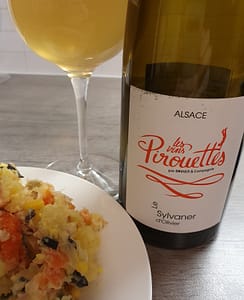La Sorga is something of a superstar on the natural wine stage. It was started in 2008 by Antony Tortul, now accompanied by his wife and by David Adell. They work as a kind of négociants, as the grapes are bought in. There are more or less 50.000 bottles produced per year. There is no shortage of creativity, so 30-40 different labels are created every year.
All grapes come from organic or biodynamic vineyards. La Sorga wines are always “zero zero”.
They work in different regions around Béziers, in the Languedoc. The climate is warm and maritime, close to the Mediterranean, so the grapes are often harvested early to maintain freshness. The soils are lime, clay and slate.
For this wine -from Corbières and Cabrerolles- cinsault 40 years old are used in 60%, the rest more than a hundred years old carignan. The grapes were picked by hand and underwent maceration carbonic for 60 days. Then followed 12 months in amphorae and bottling, clearly, without filtration or SO2.
SorGaahl 2019 (La Sorga)
Dark red with blue hue, somewhat turbid. Clear-cut aromas of blueberry, cherries and a spicy component. Luscious, juicy, but also concentrated, with a dry finish.
Price: Medium
Food: Rich vegetable dishes, light and tasty meat (chicken, lamb, pig), pizza and pasta…
Leave a Comment












